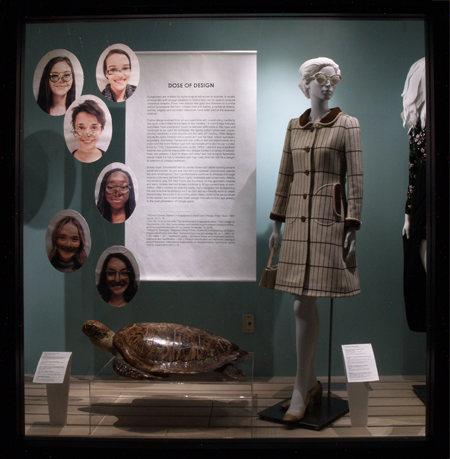
Eyeglasses are marked by technological advances in science. A variety of materials with enough plasticity to hold a lens can be used to produce inventive shapes. From rare metals like gold and titanium to humble animal by-products like horn, tortoise shell and leather, a variety of mineral, animal, vegetal and synthetic resources have been part of the eyewear arsenal.
Frame design evolved from an enclosed lens with a protruding handle to two such units riveted at the base of the handles.[1] A nose bridge followed and these “bow spectacles” could be secured with cords to the head and continued to be used for centuries: the spring action “pince-nez” (nose-pincher) remained a style popular until the early 20th century. Other designs include the Spina Frontalis with a central arm over the head, scissor spectacles, lorgnettes, monocles, frames with ear cuffs or hair pin attachments on a chain and the more familiar type with two temple arms (but no ear curves) know by 1730.[2] Discovered as early as the 1840s,[3] celluloid was a synthetic material that could be manipulated into delicate frames in a variety of outlines, hues, and patterns. It kept its shape and colour well, but its highly flammable nature made it a risk to wearers near high heat (and can still be a danger to wearers of vintage eyewear).
Modes linger: tortoiseshell with its mottled brown and yellow coloring remains extremely popular. Its use was banned from eyewear once tortoise species became endangered,[4] but manufacturers continue to emulate it through organic polymers derived from highly malleable petrochemicals. Artistic movements also left their mark: the Bauhaus’ strong geometric shapes and early rimless pierced lenses continue to fit our current love of minimalism. With a concern for reducing waste, many designers are re-examining the use of animal by-products such as horn and eco-friendly wood to create frames today. Advances in 3D printing allow classic styles to be personalized to the wearer, but it could also foster design innovations from eye jewelry to the next generation of Google glass.
[1] Richard Corson, Fashion in Eyeglasses (London and Chicago: Peter Owen, 1967: reprint, 2011), 19.
[2] Ibid., 69; “A bit on the side – The development of spectacle sides,” The College of Optometrists (UK), http://www.college-optometrists.org/en/college/museyeum/online_exhibitions/spectacles/side.cfm (accessed Nov. 13, 2016).
[3] Megan E. Springate, “Cellulose Nitrate Plastic (Celluloid) in Archaeological Assemblages: Identification and Care,” Northeast Historical Archaeology 26, no. 1 (1997): 63.
[4] ISO 10685-1: 2011, “Ophthalmic optics — Spectacle frames and sunglasses electronic catalogue and identification — Part 1: Product identification and electronic catalogue product hierarchy,” International Organization for Standardization, Ophthalmic Optics Files 8, supplement (2011): 18.
Introduction | RX | Dose of Design | Fashion Aid | Artifacts in the Exhibition| Press Release |Story in The Quad |2017 Richard Martin Award
Photograph by Anne Bissonnette©
Cite this page (bibliography):
Bissonnette, Anne,
Cybil Cameron, Katelin Karbonik, Naomi Milne, Katie Mooney, Danielle Peel, and Donnalee Riley. “Eyewear: Fashion with Vision, Dose of Design,” Exhibitions, Clothing and Textiles Collection, Department of Human Ecology, University of Alberta Museums, November 23, 2016. [INSERT URL].
LINKS TO ARTIFACTS BELOW MAY NOT BE RELATED TO THIS EXHIBITION
